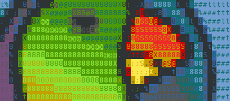Introduction¶
These days, generating massive amounts of data is an everyday element of biological research; and almost all projects have a computational biology, or bioinformatics, components. Such embedded work commonly consists of chaining a number of 3rd party tools together, often with some data manipulation in between the steps. It is important to have such projects properly organized, particularly when a projects grows bigger.
There are many different ways to organize bioinformatics projects. Many bioinformaticians use the command line or tailor made scripts to organize and automate their work. This approach has obvious advantages, most importantly flexibility. Potential downsides to scripting are that a project easily becomes disorganized and untraceable unless measures are taken.
Moa aims to assist in organizing, automating and maintaining a command line bioinformatics project without loss of flexibility.
Example¶
The best way to understand how Moa can help you to achieve this is by an example. A Moa workflow consists of separate Moa jobs. A workflow is typically organised as a directory tree, where the structure of the tree reflects the structure of the project. So, Starting a Moa project starts with outlining a directory structure to contain the workflow:
$ mkdir test.project && cd test.project
$ mkdir 00.proteins
( copy or link some protein sequences into 00.proteins )
$ mkdir 10.blast
$ cd 10.blast
An important feature of Moa is that each separate analysis step is contained within a separate directory. Two Moa jobs never share a directory. This forces a Moa user to break a workflow down to atomic parts, which is typically beneficial to the organization and coherence of a workflow. The order of steps is easily ordered by prefixing directory names with a number. Note that these prefixes are not enforced by Moa; any alphabetical organization would work as well. Once a directory is created, a Moa job can be created:
$ moa new blast -t "demo run"
All interaction with Moa is done through a single command: moa. It is, at all times, possible to get help on the use of the moa command by invoking moa –help. The command above creates a BLAST job titled “demo run” in the current directory. All Moa related files are stored in a (hidden) sub-directory names .moa (have a look!). A Moa job consists, amongst others, of a configuration file and a number of template files. All template files are copied into the .moa directory. This ensures that a workflow remains the same over time, even if the templates are updated (moa refresh would update a template to the latest version).
Another topic in which Moa tries to help is by embedding (some) documentation. In the above command line the -t parameter sets a mandatory project title (a job won’t execute without a title).
Obviously, telling a Moa job to do a BLAST analysis is not enough, some extra information will need to be given:
$ moa set db=/data/blast/db/nr
A few things could be noted here. Important is that you do not use spaces around the = sign. If you want to define a parameter with spaces, use quotes (key=”value with spaces”), and be aware of bash interpretation. A safe way of entering complex parameters is by running moa set db and Moa will query you the value.
Another point is that Moa does not give you a response. You can check the current job configuration using moa show, which would at this moment result in something resembling:
db L /data/blast/db/nr
input E (undefined)
jobid L blast
title L demo run
Note the variable db and title, which were set earlier. If you run show -a, more parameters will be revealed, amongst which is program. We will now set two more variables:
$ moa set program=blastp
$ moa set input=../00.proteins/*.fasta
The last statement defines the input files to blast. Once all is set you can actually run the BLAST analysis with:
$ moa run
Now Moa performs the BLAST analysis on the input files. The output can be found in the out sub-directory. As an extra, the Moa blast template generates a blast_report file with simple one line report for the best five hits of each query sequence. If you, for example, would like to check for the presence of dicer genes in your query set, you could grep this file:
$ grep -i dicer blast_report
Command line operation of data files can be very powerful, and this would be a typical operation for a command line bioinformatician. Moa lets you capture this and thus make it a part of the pipeline. Try:
$ moa set postcommand
and, at the prompt enter:
postcommand:
> grep -i dicer blast_report > dicer.out
If you now rerun moa, the BLAST job will not be repeated, but the postcommand will be executed and a dicer.out file will be generated. (note, there is also a precommand)
